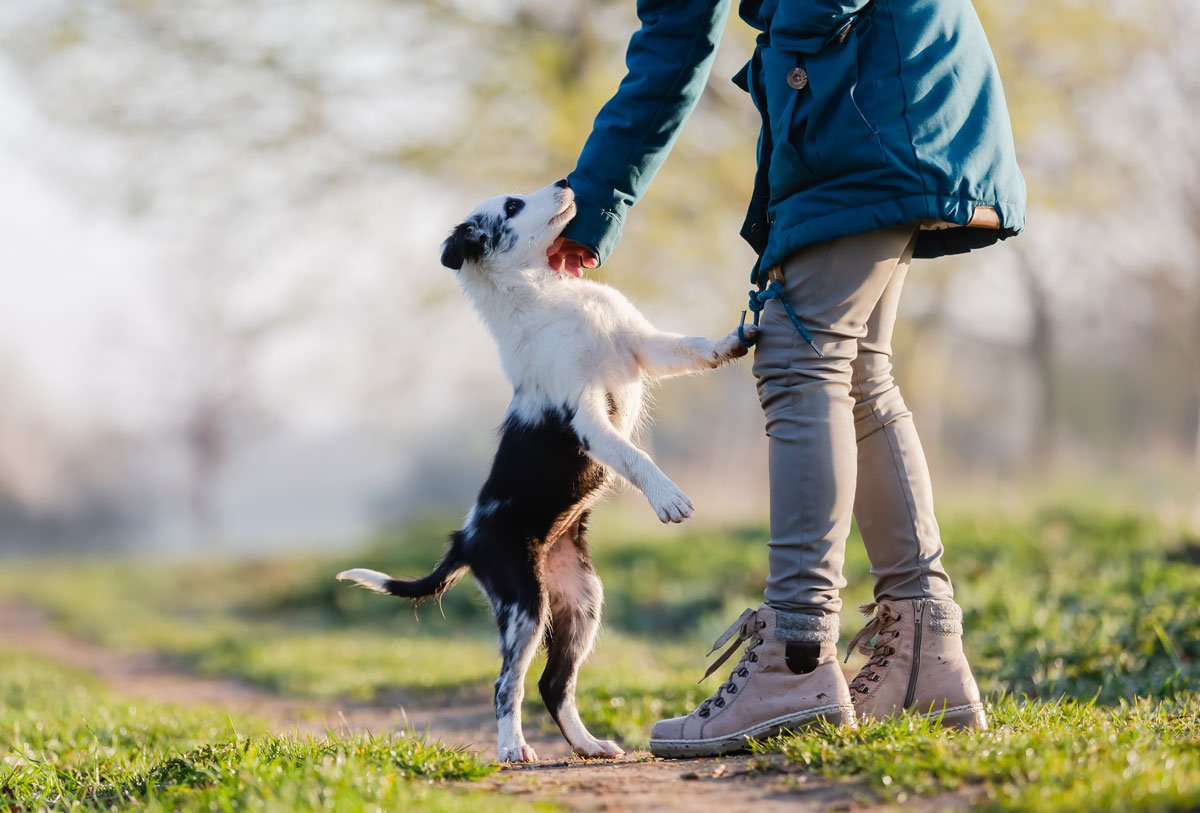For many dogs, jumping up on their people is a favorite pastime. Whether your dog excitedly jumps up on you when you get home (like mine!) or jumps to greet new people out on walks, jumping up on humans can become a behavior that is hard to prevent. It is preventable, but it can take some work.
All behaviors have a reinforcement history. Behavior that is reinforced will happen more frequently and/or with greater intensity. Behavior that is not reinforced will happen less frequently and/or with less intensity. How frequent and intense a behavior is can tell you a lot about its reinforcement history. Does your dog automatically sit every time you get to a curb when you’re out on a walk? Does your dog get excited every time you grab the leash? These examples show a strong reinforcement history.
Here’s where jumping up comes in: some behaviors are reinforcing to dogs because they are fun to do. Our dogs get something out of it even though we aren’t actively reinforcing the behavior. These kinds of behaviors (jumping up, digging, retrieving a ball, mounting) are reinforcing all by themselves. Behaviors that are fun produce endorphins, chemicals in the brain that make us, and our dogs, feel good. Think of the endorphins as little bits of chicken being popped into your dog’s mouth, reinforcing behavior.
Preventing endorphins is impossible but preventing behaviors that lead to the creation of these endorphins is possible. Our best bet is to reinforce a behavior that is incompatible with the one we are trying to prevent. Sit is a common one for jumping up. Your dog can’t jump up if he or she is sitting. Sitting is incompatible with jumping up. Teaching our dogs to sit when presented with the very same situations that cause them to jump up is usually the best strategy to prevent this common behavior problem.
How can we gain control of this behavior so that we can prevent it from happening? Like most training, we can start by teaching the dog what we want them to do instead. Usually, I recommend finding a behavior that your dog can perform that can be reinforced well and that is also inconsistent with jumping up – something like sitting, or touching your hand with their nose, or fetching a toy or ball. When greeting a new person, if a dog learns to sit to say Hi, the dog can’t sit and jump up at the same time. So, we can teach a dog to sit, and that sitting can lead to the same forms of reinforcement your dog was getting for jumping up.
The trick to this strategy is to take some time to teach it. One of the biggest challenges with this approach is being realistic about any history your dog has had with using jumping to get attention. Many dogs have a strong history of that behavior working quite well to gain access to things they like. You could look at it as a habit that you’d like to change. And like habits that we form, they can be difficult to change quickly.
Think about anytime you’ve tried to change your patterns of eating. Say you typically stop at a cafe to get a coffee and a muffin during your work break every day. Let’s say you wanted to stop getting a muffin every day. The habit that you’ve formed has been reinforced for several weeks. Even though you want to make a change, every day you continue to have that craving for the muffin because your body is used to getting it every day. The craving was your cue to get it, and the craving is persisting.
The same process occurs with our dogs when they have learned something that we’d like to change. They are using a strategy that has worked quite well for a while. Our job is to set up the training so that they begin to learn a new way to get what they want.
Jumping Up on People as They Enter the House
Remember that your dog is super excited to see you when you come home and typically seems unable to listen to anything you say, so talking and using cues is out of the question in this moment. Here’s what I would try.
Step One: I’d open the door and toss a few tasty treats into the room, right past my dog’s nose so that she could follow them to the floor. Once she’s stepped away from the door to get the treats, I wait for her to finish the treats and then toss some more when she looks up at me. I’d move into the room in this manner, tossing a treat or two every time she looks up at me after finishing the last one, and I’d move her through the space by tossing these treats so that I could get into the house. If I do this well, I don’t experience any jumping at all. This new game is fun for her, and we are interacting socially, but there is no jumping!
Step Two: I would then experiment to see if she could sit for me before I toss the next treat. I ask for a sit and she sits! I then toss the treat so that she has to go get it. I’d ask for another sit and repeat this game several times. She sits, I toss away so she has to go collect the treat.
Step Three: I’d find a place to sit myself, I’m tired after a long day after all, and continue this sit and toss game. She’s sitting really well. I’d then begin to replace some of the food treats with petting her or playing together with a toy – because that’s really what she’s after, some good physical interaction. She’s been without it all day. I’d ask her to sit, then reward that with some calm petting on her chest, and then a game of tug. If she gets too worked up and begins to climb on me, I’d ask for a sit and then toss the treat again. I’d work with her with this game until she can interact calmly with the physical petting but I’d continue with the treat tossing so that she can burn off some of that pent up energy that has developed while I’ve been at work.
By using a strategy like this one, you engage your dog in some sort of fun activity that enables her to expend some energy while learning a new way to be social with you when you get home. I’d repeat this every day for a week or two while gradually bringing back some verbal cueing to get her to respond to that in addition to the food toss. “Get it” or “Find it” could be a cue you use right before you toss the treat. This preps her to go get the food. It creates anticipation of the food coming and increases her motivation to get the treat. Oh, and it does not increase jumping like ignoring does! I’d use this strategy to shape my dog to stay on the floor while having a good time and interacting with me in this new predictable way. Everybody wins and there’s no need to punish the dog at all. She’s having fun and so am I. She gets to eat part of her dinner as I help her to cope with her pent up energy and strong desire to interact socially in this new way that does not involve any behavior that I don’t like. Bingo! We’ve done it!



